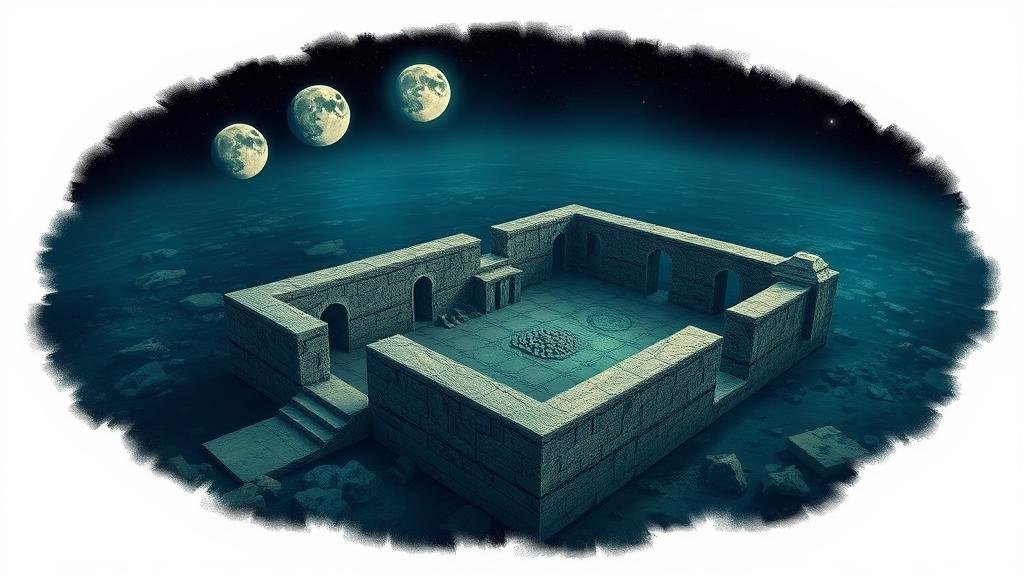Mapping underwater ruins visible only during specific lunar phases.
Mapping Underwater Ruins Visible Only During Specific Lunar Phases
The phenomenon of underwater ruins becoming visible during certain lunar phases has piqued the interest of archaeologists, historians, and ocean enthusiasts alike. These submerged sites provide a unique glimpse into human history, showcasing civilizations that once thrived near coastlines that are now long submerged. This article delves into the mechanics of lunar phases, notable examples of submerged ruins, and the significance of these archaeological treasures.
The Influence of Lunar Phases on Visibility
Lunar phases refer to the various stages of the Moons cycle, which lasts approximately 29.5 days. e phases impact natural light levels and tidal patterns, which are crucial for underwater visibility. The gravitational pull exerted by the Moon influences tide heights, and during specific phases, like the new moon and full moon, extreme tidal conditions can expose these underwater remains when water levels recede.
- During the New Moon, lower tides can reveal structures that are usually submerged.
- The Full Moon brings similarly low tides, often following a stronger gravitational pull, increasing visibility.
The synergy between tidal patterns and lunar visibility plays a vital role in the exploration of such ruins, highlighting the importance of precise timing in mapping these sites.
Notable Underwater Ruins
Several remarkable sites around the world can be explored during specific lunar phases:
- Yonaguni Monument, Japan: Located off the coast of Yonaguni, this underwater site features large stone formations resembling terraced steps. Often debated as a natural formation or human-made relic, it becomes particularly visible during low tides associated with new and full moons.
- Cleopatra’s Palace, Egypt: Underwater ruins near Alexandria belong to what was once a resplendent palace of Cleopatra. Divers often explore these ruins during lower tides when visibility improves, allowing insight into Greco-Roman maritime culture.
- Thonis-Heracleion, Egypt: Known as Egypt’s lost city, Thonis-Heracleion appears significantly during the times of lower tides, typically around the full moon. Evidence suggests this city was a major trade hub before it submerged into the Mediterranean.
The Process of Mapping Underwater Ruins
Mapping underwater ruins requires advanced technology and meticulous planning, particularly aligned with lunar cycles. Techniques employed often include:
- Sonar Imaging: Multibeam sonar systems allow researchers to create detailed maps of the ocean floor, revealing the outlines of ancient structures.
- Remote Operated Vehicles (ROVs): ROVs equipped with cameras and manipulators can access these submerged sites during optimal lunar conditions, providing real-time data for researchers.
- Underwater Drones: Recent advancements in drone technology facilitate exploration and documentation with minimal human risk, especially during periods when ruins are partially exposed.
The collaboration of technology with natural lunar events enables comprehensive mapping and enhances our understanding of these historical sites.
Significance of Studying Underwater Ruins
The study of underwater ruins provides invaluable insight into ancient civilizations, their structures, and the environmental changes that led to their submergence. By examining these sites, researchers can uncover:
- Cultural heritage: Artifacts recovered from sites like Thonis-Heracleion help reconstruct historical narratives and understand historical trade routes.
- Environmental impact: Insights into how rising sea levels shaped human settlements can inform current discussions on climate change and coastal management.
- Technological advancements: Techniques developed for underwater exploration contribute to other fields, including construction, environmental monitoring, and robotics.
Real-World Applications
The study of these submerged ruins has practical applications not only in archaeology but also in environmental policy and tourism. For example, the discovery of the Yonaguni Monument has fostered eco-tourism in Japan, attracting divers and historians alike, while creating awareness about marine conservation.
Conclusion
Mapping underwater ruins that become visible only during specific lunar phases merges the realms of archaeology and natural sciences. By harnessing the power of lunar cycles, researchers can uncover insights about past civilizations while enriching our modern understanding of environmental processes. In this way, the Moon not just shapes tides but also histories–an ever-present partner in revealing the treasures of our submerged past.
As we advance our technological capabilities and improve our understanding of lunar impacts, further exploration of these ruins is not just possible but increasingly accessible. Whether you are a diving enthusiast, a budding archaeologist, or simply curious about history, the allure of these underwater treasures remains a beacon for exploration.



